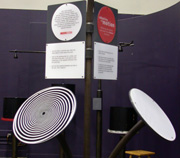


|
Perception
|
Adapting to Motion
Your
visual system adapts to spinning motion in Adapting to Motion. When
you first stare at a spinning spiral, it appears to move in and
out. If you continue to stare for 15 or 20 seconds, one set of motion
detectors in your eye becomes tired, and the motion of the spiral
appears to stop. When you look away from the spiral at something
stationary, the opposite set of motion detectors takes over and
you briefly see motion in the opposite direction.
A black and white spiral slowly spins. Visitors stare at the center
of the spiral for twenty seconds or more and then suddenly look
at other objects. The objects appear to swell up or to shrink. Visitors
control the direction of rotation of the spiral with a switch and
its speed with a knob.
As the spiral turns it appears to expand or contract depending on
its direction of rotation. There are two channels in the part of
the optic pathway in the brain which detects expanding and shrinking
sizes. Nerves in one channel fire when it detects objects which
expand, nerves in the other fire when they detect shrinkage. If
an object does not change size both of these channels fire in balance.
However, if an expanding object is viewed for many seconds, the
firing rate of the expansion-detecting channel decreases. The decrease
in firing rate continues for a while even once the visitor has looked
away from the spiral, so that when a stationary object is viewed
and the shrinkage-detecting channel continues to fire at an undiminished
rate, the stationary object is then seen to shrink.
An object usually appears to expand or shrink because it is moving
toward or away from a viewer. An expanding object is seen as approaching,
a shrinking one is seen as receding.
|

|







|